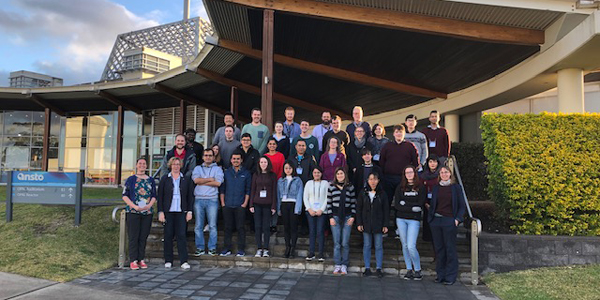Traditional HZB Neutron School will be continued at ANSTO in Australia

The neutron school at ANSTO in cooperation with HZB experts could transfer knowledge and skills in neutron research. © ANSTO
This summer, researchers at the Australian neutron source ACNS organised a joint neutron school at Australia's Nuclear Science and Technology Organisation ANSTO. The HZB-ANSTO neutron school will take place every two years.
The first joint HZB-ANSTO neutron school took place from 23 to 28 June 2019 at ANSTO. HZB experts Prof. Dr. Bella Lake and Prof. Dr. Susan Schorr held several lectures. The interest in the neutron school was high, 24 participants were selected from 60 applications. In addition to lectures, hands on trainings on three instruments of the neutron source ACNS at ANSTO have been offered.
“Certainly we were inspired by the all-encompassing nature of the Berlin school - I believe that our plan going forward would be to run a 'general' neutron school every two years and a more specific school in between," said Dr. Helen Maynard-Casely, one of the organisers at ANSTO.
Shortly before the start of the neutron school, the SPATZ neutron reflectometer at ACNS was inaugurated. SPATZ, formerly known as BioRef at the BER II at HZB, is ideally suited for studies of soft matter in biomedicine, energy and materials. It was donated by HZB to ANSTO since the BER II neutron source will be shut down end of 2019.
In a short video, ANSTO presents SPATZ and its virtues.
arö
https://www.helmholtz-berlin.de/pubbin/news_seite?nid=20628;sprache=en
- Copy link
-
BESSY II: Heterostructures for Spintronics
Spintronic devices work with spin textures caused by quantum-physical interactions. A Spanish-German collaboration has now studied graphene-cobalt-iridium heterostructures at BESSY II. The results show how two desired quantum-physical effects reinforce each other in these heterostructures. This could lead to new spintronic devices based on these materials.
-
Green hydrogen: MXenes shows talent as catalyst for oxygen evolution
The MXene class of materials has many talents. An international team led by HZB chemist Michelle Browne has now demonstrated that MXenes, properly functionalised, are excellent catalysts for the oxygen evolution reaction in electrolytic water splitting. They are more stable and efficient than the best metal oxide catalysts currently available. The team is now extensively characterising these MXene catalysts for water splitting at the Berlin X-ray source BESSY II and Soleil Synchrotron in France.
-
SpinMagIC: 'EPR on a chip' ensures quality of olive oil and beer
The first sign of spoilage in many food products is the formation of free radicals, which reduces the shelf-life and the overall quality of the food. Until now, the detection of these molecules has been very costly for the food companies. Researchers at HZB and the University of Stuttgart have developed a portable, small and inexpensive 'EPR on a chip' sensor that can detect free radicals even at very low concentrations. They are now working to set up a spin-off company, supported by the EXIST research transfer programme of the German Federal Ministry of Economics and Climate Protection. The EPRoC sensor will initially be used in the production of olive oil and beer to ensure the quality of these products.
